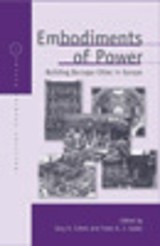Details

Embodiments of Power
Building Baroque Cities in EuropeAustrian and Habsburg Studies, Band 10 1. Aufl.
|
38,99 € |
|
| Verlag: | Berghahn Books |
| Format: | |
| Veröffentl.: | 01.07.2008 |
| ISBN/EAN: | 9780857450500 |
| Sprache: | englisch |
| Anzahl Seiten: | 320 |
DRM-geschütztes eBook, Sie benötigen z.B. Adobe Digital Editions und eine Adobe ID zum Lesen.
Beschreibungen
<p> The period of the baroque (late sixteenth to mid-eighteenth centuries) saw extensive reconfiguration of European cities and their public spaces. Yet, this transformation cannot be limited merely to signifying a style of art, architecture, and decor. Rather, the dynamism, emotionality, and potential for grandeur that were inherent in the baroque style developed in close interaction with the need and desire of post-Reformation Europeans to find visual expression for the new political, confessional, and societal realities. Highly illustrated, this volume examines these complex interrelationships among architecture and art, power, religion, and society from a wide range of viewpoints and localities. From Krakow to Madrid and from Naples to Dresden, cities were reconfigured visually as well as politically and socially. Power, in both its political and architectural guises, had to be negotiated among constituents ranging from monarchs and high churchmen to ordinary citizens. Within this process, both rulers and ruled were transformed: Europe left behind the last vestiges of the medieval and arrived on the threshold of the modern.</p>
<p> List of Illustrations</p>
<p> <b>Introduction</b><br> <i>Gary B. Cohen</i> and <i>Franz A. J. Szabo</i></p>
<p> <b>Chapter 1.</b> Embodiments of Power? Baroque architecture in the former Habsburg Residences of Graz and Innsbruck<br> <i>Mark Hengerer</i></p>
<p> <b>Chapter 2.</b> Baroque Comes for the Archbishops: Wolf Dietrich von Raitenau, Johann Ernst Count Thun and Their Ideals of 'Modern Art' and Architecture<br> <i>Roswitha Juffinger</i></p>
<p> <b>Chapter 3.</b> Religious Art and the Formation of a Catholic Identity in Baroque Prague<br> <i>Howard Louthan</i></p>
<p> <b>Chapter 4.</b> Prague, Wroclaw and Vienna: Center and Periphery in Transformations of Baroque Culture?<br> <i>Jiri Pesek</i></p>
<p> <b>Chapter 5.</b> Representation of the Court and Burghers in the Baroque Cities of the High Road: Krakow, Wrocław and Dresden in a Historical Comparison<br> <i>Jan Harasimowicz</i></p>
<p> <b>Chapter 6.</b> From Protestant Fortress to Baroque Apotheosis: Dresden from the Sixteenth to the Eighteenth Century<br> <i>Barbara Marx</i></p>
<p> <b>Chapter 7.</b> A Tale of Two Cities: Nuremberg and Munich<br> <i>Jeffrey Chipps Smith</i></p>
<p> <b>Chapter 8.</b> Searching for the New Constantine: Early Modern Rome as a Spanish Imperial City<br> <i>Thomas Dandelet</i></p>
<p> <b>Chapter 9.</b> The Zodiac in the Streets: Inscribing <i>Buon Governo</i> in Baroque Naples<br> <i>John A. Marino</i></p>
<p> <b>Chapter 10.</b> A Setting for Royal Authority: The Reshaping of Madrid, Sixteenth/Eighteenth Centuries<br> <i>David Ringrose</i></p>
<p> Notes on Contributors<br> Bibliography<br> Index</p>
<p> <b>Introduction</b><br> <i>Gary B. Cohen</i> and <i>Franz A. J. Szabo</i></p>
<p> <b>Chapter 1.</b> Embodiments of Power? Baroque architecture in the former Habsburg Residences of Graz and Innsbruck<br> <i>Mark Hengerer</i></p>
<p> <b>Chapter 2.</b> Baroque Comes for the Archbishops: Wolf Dietrich von Raitenau, Johann Ernst Count Thun and Their Ideals of 'Modern Art' and Architecture<br> <i>Roswitha Juffinger</i></p>
<p> <b>Chapter 3.</b> Religious Art and the Formation of a Catholic Identity in Baroque Prague<br> <i>Howard Louthan</i></p>
<p> <b>Chapter 4.</b> Prague, Wroclaw and Vienna: Center and Periphery in Transformations of Baroque Culture?<br> <i>Jiri Pesek</i></p>
<p> <b>Chapter 5.</b> Representation of the Court and Burghers in the Baroque Cities of the High Road: Krakow, Wrocław and Dresden in a Historical Comparison<br> <i>Jan Harasimowicz</i></p>
<p> <b>Chapter 6.</b> From Protestant Fortress to Baroque Apotheosis: Dresden from the Sixteenth to the Eighteenth Century<br> <i>Barbara Marx</i></p>
<p> <b>Chapter 7.</b> A Tale of Two Cities: Nuremberg and Munich<br> <i>Jeffrey Chipps Smith</i></p>
<p> <b>Chapter 8.</b> Searching for the New Constantine: Early Modern Rome as a Spanish Imperial City<br> <i>Thomas Dandelet</i></p>
<p> <b>Chapter 9.</b> The Zodiac in the Streets: Inscribing <i>Buon Governo</i> in Baroque Naples<br> <i>John A. Marino</i></p>
<p> <b>Chapter 10.</b> A Setting for Royal Authority: The Reshaping of Madrid, Sixteenth/Eighteenth Centuries<br> <i>David Ringrose</i></p>
<p> Notes on Contributors<br> Bibliography<br> Index</p>
<p> <b>Gary B. Cohen</b> is director of the Center for Austrian Studies and professor of history at the University of Minnesota, Twin Cities. He teaches modern Central European social and political history and has published numerous articles and essays as well as two books in these areas.</p>
Diese Produkte könnten Sie auch interessieren:

Kriegspropaganda in der Habsburgermonarchie zur Zeit des Ersten Weltkriegs

von: Christian Schwendinger

29,99 €
















